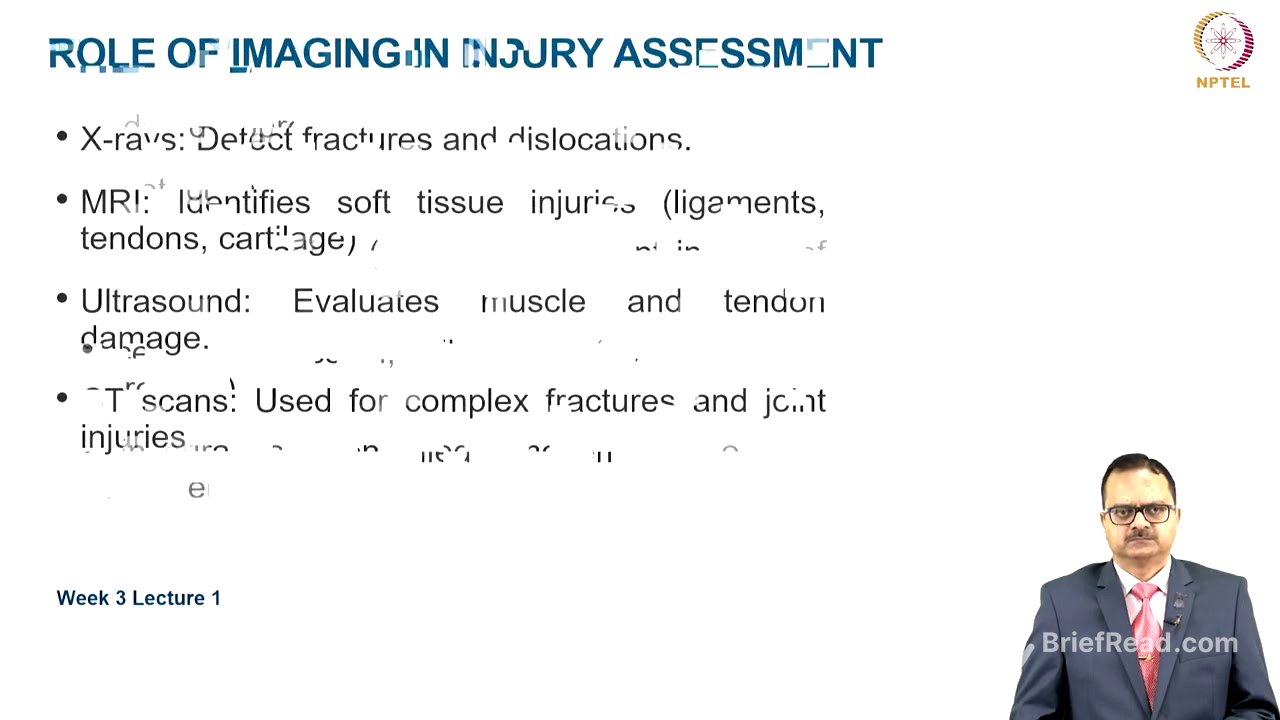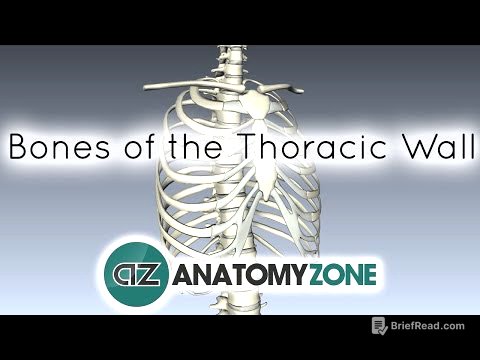TLDR;
This lecture provides a comprehensive overview of acute sports injuries, covering their classification, causes, types, clinical features, assessment protocols, and management strategies. It emphasizes the importance of immediate and structured injury assessment to prevent further damage and facilitate effective treatment and rehabilitation. The lecture also touches on advances and future trends in sports injury management, such as regenerative medicine, wearable technology, and telemedicine.
- Acute sports injuries require immediate assessment to prevent further damage and ensure effective management.
- Structured injury assessment protocols, like Doctor ABC, HOPS, and SALTAPS, are crucial for delivering a high standard of care.
- Management strategies include PRICE and POLICE protocols, with a focus on protection, optimal loading, ice, compression, and elevation.
- Awareness of red flags and strict adherence to return-to-play criteria are essential for athlete safety.
Introduction to Acute Sports Injuries [0:15]
The lecture introduces the topic of acute sports injuries, emphasizing their sudden onset due to trauma and the critical need for immediate assessment for effective management and faster recovery. A structured injury assessment protocol is essential for delivering a better standard of care, preventing a haphazard approach. The lecture will cover the classification of sports injuries, causes and types, clinical features, assessment and management protocols, advances and future trends, and conclude with a take-home message.
Classification of Sports Injuries [1:40]
Sports injuries are classified into acute, chronic/repetitive stress, contact, and non-contact injuries. Acute injuries occur suddenly due to internal or external forces, such as fractures, sprains, and contusions. Chronic injuries develop over time due to repetitive stress, like tendinopathy and stress fractures. Contact injuries result from collisions or direct blows, while non-contact injuries occur without external impact, often due to biomechanical issues.
Causes and Types of Acute Sports Injuries [2:29]
Common causes of acute sports injuries include direct trauma from external impacts like tackles and falls, indirect trauma from excessive force causing ligament or muscle tears (e.g., sudden changes in direction), and overuse leading to acute episodes or chronic injuries. Types of acute injuries include sprains (ligament damage), strains (muscle or tendon injuries), fractures (bone breaks), dislocations/subluxations (joint misalignment), and contusions (bruising from direct impact). The biomechanics of these injuries involve compressive, torsional, or shear forces exceeding the tissue's load tolerance. The kinetic chain concept highlights how interconnected body segments can contribute to injury risk in other areas.
Signs, Symptoms, and Importance of Immediate Injury Assessment [5:13]
Signs and symptoms of acute injuries include pain and tenderness at the injury site, swelling, bruising, deformity, reduced range of motion, and inability to bear weight or perform normal movements. Immediate injury assessment is crucial to prevent further damage, determine the severity of the injury, guide treatment progression, aid in return-to-play decisions, and facilitate rehabilitation planning.
On-field Assessment: Doctor ABC Protocol [6:25]
On-field assessment, or primary survey, follows the Doctor ABC protocol: Danger (ensure a safe environment), Response (check the athlete's level of consciousness), Airway (check for obstructions and open the airway using head tilt-chin lift or jaw thrust if cervical injury is suspected), Breathing (ensure normal breathing), and Circulation (check pulse and bleeding). After addressing life-threatening conditions, proceed to the secondary survey.
Secondary Survey: HOPS Protocol and SALTAPS Algorithm [8:29]
The secondary survey involves a detailed assessment using the HOPS protocol: History (mechanism of injury, symptoms, past injuries), Observation (swelling, deformities, scars), Palpation (pain points, structural damage, joint integrity), and Special/Functional Testing (range of motion, strength, stability). The SALTAPS algorithm is used for dealing with acute sports injuries: Stop play, Ask about pain and symptoms, Look for swelling/deformity/discoloration, Touch and palpate for pain, Active movements by the athlete, Passive movements by the examiner, and Strength testing.
Management: PRICE and POLICE Protocols [10:26]
Management of acute injuries starts with the PRICE protocol: Protection, Rest, Ice, Compression, and Elevation. The updated POLICE principle emphasizes Protection, Optimal Loading (gradual movement instead of complete rest), Ice, Compression, and Elevation, encouraging controlled movement to aid recovery.
Role of Imaging in Injury Assessment [11:35]
Imaging plays a significant role in injury assessment. X-rays detect fractures and dislocations. MRI identifies soft tissue injuries to ligaments, tendons, cartilage, and muscles. Ultrasound evaluates muscle and tendon damage, assessing real-time movement. CT scans are used for complex fractures and joint injuries.
Red Flags and Management of Specific Injuries [12:19]
Red flags in acute injury assessment include intense pain, loss of function, deformity, open wounds, numbness, and signs of concussion. If any red flags are present, the athlete should be immediately removed from the field and taken for medical evaluation. Management of specific injuries includes RICE, rehabilitation, and therapeutic exercises for sprains/strains; immobilization and surgery for fractures; reduction and stabilization for dislocations; and compression, ice, and protection for contusions.
Concussion Assessment and Management [13:36]
Concussion assessment and management are crucial due to the prevalence of head injuries in sports. The SCAT 6 (Sports Concussion Assessment Tool 6) is an important tool for evaluation, ideally used with baseline data. Gradual return-to-play protocols are essential, and athletes should not return if symptoms persist to avoid second impact syndrome.
Emergency Care and Return to Play Decision Making [15:08]
Emergency care for severe injuries includes safe handling of spinal injuries, suspecting cervical spine injuries in trauma, and immobilizing the individual on a spinal board with a cervical collar. Awareness of managing open fractures, severe bleeding, and training in cardiopulmonary resuscitation (CPR) for cardiac emergencies are vital. Return-to-play decisions require pain-free range of motion, strength within 90% of the unaffected limb, functional testing, and sport-specific assessments.
Role of Sports Medicine Professionals and Injury Prevention Strategies [16:43]
Sports medicine professionals, including team physicians, sports physiotherapists, and athletic trainers, play key roles in injury assessment, rehabilitation, and prevention. They also educate athletes on self-care and injury prevention. Injury prevention strategies emphasize warm-ups and cool-downs, detailed strength and conditioning programs, and biomechanical corrections integrated into training.
Psychological Impact of Injuries [17:42]
Acute injuries have a significant psychological impact on athletes, eliciting strong emotional responses. Managing this requires teaching mental strategies for coping with injury and rehabilitation, potentially involving a sports psychologist.
Advances and Future Trends in Injury Management [18:13]
Advances in acute injury management include regenerative medicine (platelet-rich plasma and stem cell therapy), wearable technology for injury monitoring, and artificial intelligence-assisted injury risk prediction. Future trends involve telemedicine for remote consultation, virtual reality for rehabilitation, and machine learning tools for injury prediction.
Take-Home Message [19:29]
Key takeaways include understanding that acute sports injuries encompass sprains, fractures, contusions, and dislocations. Injury assessment involves primary (life-threatening conditions) and secondary (detailed physical evaluation) assessments. Immediate management includes PRICE and POLICE protocols. Key assessment tools are the SALTAPS method, SCAT 6 for concussion, X-rays, MRI, CT scans, and ultrasound. Awareness of red flags is crucial, and strict return-to-play criteria must be followed. Future trends include AI-based injury predictions, regenerative medicine, and wearable injury monitoring.





![[Digimon Movie Commentary Podcast] LiT Special 34 - DigiKatamari](https://wm-img.halpindev.com/p-briefread_c-10_b-10/urlb/aHR0cDovL2ltZy55b3V0dWJlLmNvbS92aS9xUzY2TnRRS2dQcy9ocWRlZmF1bHQuanBn.jpg)



